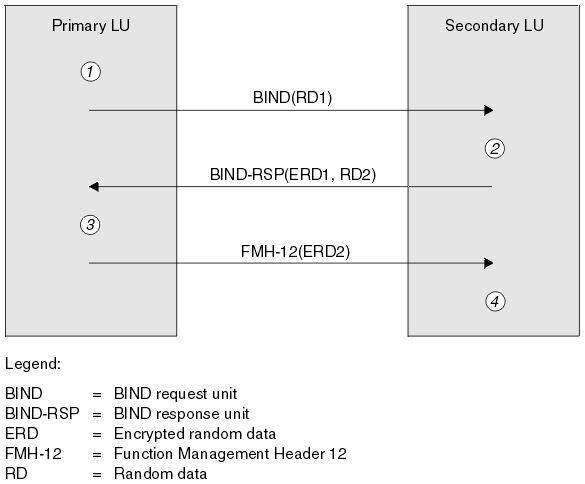Session level authentication
Session level authentication is a session level security protocol that enables two LUs to authenticate each other while they are activating a session. It is also known as LU-LU verification.
Because an LU is effectively the gateway
into a system from the network, you might consider this level of authentication to be sufficient in certain circumstances. For example, if your queue manager needs to exchange messages with a remote queue manager that is running in a controlled and trusted environment, you might be prepared to trust the identities of the remaining components of the remote system after the LU has been authenticated.
Session level authentication is achieved by each LU verifying its partner's password. The password is called an LU-LU password because one password is established between each pair of LUs. The way that an LU-LU password is established is implementation dependent and outside the scope of SNA.

- The primary LU generates a random data value (RD1) and sends it to the secondary LU in the BIND request.
- When the secondary LU receives the BIND request with the random data, it encrypts the data using the DES algorithm with its copy of the LU-LU password as the key. The secondary LU then generates a second random data value (RD2) and sends it, with the encrypted data (ERD1), to the primary LU in the BIND response.
- When the primary LU receives the BIND response, it computes its own version of the encrypted data from the random data it generated originally. It does this by using the DES algorithm with its copy of the LU-LU password as the key. It then compares its version with the encrypted data that it received in the BIND response. If the two values are the same, the primary LU knows that the secondary LU has the same password as it does and the secondary LU is authenticated. If the two values do not match, the primary LU terminates the session.
The primary LU then encrypts the random data that it received in the BIND response and sends the encrypted data (ERD2) to the secondary LU in a Function Management Header 12 (FMH-12).
- When the secondary LU receives the FMH-12, it computes its own version of the encrypted data from the random data it generated. It then compares its version with the encrypted data that it received in the FMH-12. If the two values are the same, the primary LU is authenticated. If the two values do not match, the secondary LU terminates the session.
In an enhanced version of the protocol, which provides better protection against man in the middle attacks, the secondary LU computes a DES Message Authentication Code (MAC) from RD1, RD2, and the fully qualified name of the secondary LU, using its copy of the LU-LU password as the key. The secondary LU sends the MAC to the primary LU in the BIND response instead of ERD1.
The primary LU authenticates the secondary LU by computing its own version of the MAC, which it compares with the MAC received in the BIND response. The primary LU then computes a second MAC from RD1 and RD2, and sends the MAC to the secondary LU in the FMH-12 instead of ERD2.
The secondary LU authenticates the primary LU by computing its own version of the second MAC, which it compares with the MAC received in the FMH-12.
For information about how to configure session level authentication, see the documentation for your SNA subsystem. For more general information about session level authentication, see Systems Network Architecture LU 6.2 Reference: Peer Protocols, SC31-6808.